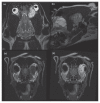Retrobulbar malignant peripheral nerve sheath tumor in a golden retriever dog: A challenging diagnosis
- PMID: 29606723
- PMCID: PMC5855229
Retrobulbar malignant peripheral nerve sheath tumor in a golden retriever dog: A challenging diagnosis
Abstract
A 9-year-old golden retriever dog was diagnosed with a left retrobulbar mass. Fine-needle aspirations and incisional biopsies resulted in discordant diagnoses: myxosarcoma/myxoma or rhadomyosarcoma, respectively. Immunohistochemistry following exenteration allowed definitive diagnosis of malignant peripheral nerve sheath tumor with fibromyxomatous differentiation. Fifteen weeks after surgery, an aggressive recurrence resulted in euthanasia.
Tumeur rétrobulbaire maligne des gaines nerveuses périphériques chez un Golden Retriever : un défi diagnostique. Une masse rétrobulbaire gauche a été diagnostiquée chez une Golden Retriever de 9 ans. Des aspirations à l’aiguille fine et des biopsies incisionnelles ont établi des diagnostics discordants : un myxosarcome/myxome ou un rhabdomyosarcome, respectivement. Suite à l’exentération, l’immunohistochimie a permis un diagnostic définitif de tumeur maligne des gaines nerveuses périphériques avec différenciation fibro-myxomateuse. Quinze semaines après la chirurgie, une récidive agressive a conduit à l’euthanasie de la chienne.(Traduit par les auteurs).
Figures




References
-
- Attali-Soussay K, Jegou JP, Clerc B. Retrobulbar tumors in dogs and cats: 25 cases. Vet Ophthalmol. 2001;4:19–27. - PubMed
-
- Hendrix DV, Gelatt KN. Diagnosis, treatment and outcome of orbital neoplasia in dogs: A retrospective study of 44 cases. J Small Anim Pract. 2000;41:105–108. - PubMed
-
- Sfacteria A, Perillo L, Macrì F, Lanteri G, Rifici C, Mazzullo G. Peripheral nerve sheath tumor invading the nasal cavities of a 6-year-old female Pointer dog. Vet Q. 2015;35:170–173. - PubMed
-
- Curto E, Clode AB, Durrant J, Montgomery KW, Gilger BC. Retrobulbar pigmented peripheral nerve sheath tumor in a dog. Vet Ophthalmol. 2016;19:518–524. - PubMed
Publication types
MeSH terms
LinkOut - more resources
Full Text Sources
